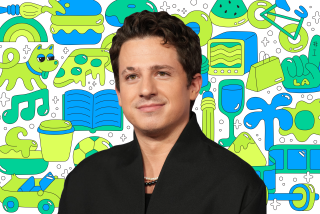Tinseltown Comes Up With Its Own Trashy Ideas for Dressing a Movie Set
Journalist Henk Friezer of Eagle Rock, who hands out food to the needy in downtown L.A. each week, was shocked to see the condition of one small homeless encampment on Beverly Boulevard. Trash was strewn everywhere. Friezer couldn’t figure it out, because the two fellows who live there are usually very neat. He found them, and they explained that a movie company had decided to use their site to shoot a homeless scene. But the Hollywood types wanted to create their own “realistic” camp. So the two fellows had to take their belongings down the street. The movie-makers brought in catered trash.
One of the homeless men, eyeing the mess, told Friezer: “I would never live that way.”
One-two punch: Bob McKewen of San Diego returned from a visit to northern England with a numbered set of snapshots (see photos).
First, we’ll start with the Twice Brewed area. It derived its name from an inn whose ale was so weak that customers demanded that it be brewed a second time.
Years later, a youth hostel opened nearby, and one of the sponsors decreed that “there will be no alcohol served on these premises, so I hope the tea and coffee will only be brewed once.” That facility became known as the Once Brewed Youth Hostel and is now part of the Once Brewed Northumberland National Park Visitor Centre.
And, no, I couldn’t find a Three-peat area nearby.
Frisbee foundations: The new book “California Firsts” is an entertaining collection of this state’s contributions to the rest of the world--whether or not the rest of the world was ready for them. The Pluto Platter (later the Frisbee) went into production at Wham-O of San Gabriel in 1957. The same company introduced the Hula Hoop the next year.
Culinary contributions include the Cobb salad (1937, Brown Derby), the double-deck hamburger (1937, Bob’s Big Boy of Glendale) and the French dip sandwich (Philippe, 1918). And Barbie, who would never go near a double-deck hamburger, judging from her figure, also was born here. The year was 1959, though she doesn’t like to admit her age.
“California Firsts” (Part II): I must, however, take issue with author Teri Davis Greenberg about the first drive-in church. She credits the Rev. Robert Schuller, who on Sunday, March 27, 1955, “stepped atop the tarpaper roof of the Orange Drive-In’s snack bar and began preaching to curious worshipers who sat in their cars.”
Actually that honor belongs to the Rev. Norman L. Hammer of North Hollywood’s Emmanuel Lutheran Church, who first preached to parked cars on July 10, 1949 (see photo).
Hammer’s theory was that more people would attend church if they could show up in casual clothes hidden behind car doors.
*
Steve Harvey can be reached at (800) LA-TIMES, Ext. 77083, by fax at (213) 237-4712, by mail at Metro, L.A. Times, 202 W. 1st St., L.A. 90012 and by e-mail at steve. [email protected].


